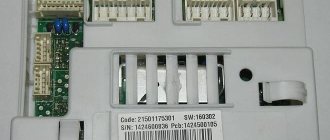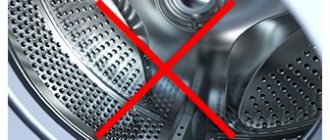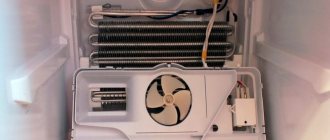A dishwasher is a reliable assistant in any kitchen. Leading equipment manufacturers such as Ariston, Electrolux, Hansa, Bosch, Beko, Gorenje, Indesit, Mile, Merloni, Zanussi, AEG, Ardo and others equip their models with innovations, constantly work to improve product quality, and introduce modern technological solutions into new products. But any equipment needs regular maintenance and repair. Even with the most reliable models, sometimes various kinds of troubles occur: water does not fill, a leak occurs, or water does not drain from the dishwasher. However, today we will talk about a fairly common problem - the dishwasher does not fill with water.
If you notice that for some reason there is no water flowing into the dishwasher, do not rush to call the service center and call a technician. Perhaps the problem is related to blockages or minor faults that can easily be fixed with your own hands. So, if you notice that your Bosch dishwasher or any other model is not drawing water, first check the water pressure in the water supply system, is the water supply valve open? It would seem obvious, but many users panic and start calling the specialists without double-checking such little things. If your dishwasher is humming and squealing but won't fill with water, check the water pressure first. Is the dishwasher valve open? Well, let's start finding and fixing problems.
Intake filter clogged
Just like with washing machines, the dishwasher inlet filter can become clogged with a variety of solid particles. To prevent this from happening later, we recommend installing a filter at the input.
Instructions for cleaning the inlet filter:
- Turn off the water, unscrew the hose and drain all the liquid from it.
- Take pliers and, with precise movements, pull the plastic filter out of the valve, rinse it thoroughly under running water.
- Insert the filter back and connect the hose.
Diagnosis of the causes and troubleshooting of the dishwasher
The most common reasons why your dishwasher won't fill with water include:
- the door is not tightly closed because the door lock is broken;
- the filter is clogged;
- the Aquastop system has blocked the fluid supply;
- the temperature sensor has broken or the heating element has burned out;
- problems with the control module;
- the filling valve has failed;
- The water level sensor is broken.
Some of the reasons can be eliminated yourself, for example, by cleaning the filters. More complex breakdowns require certain knowledge and special tools.
Advice. If your dishwasher is under warranty, contact a professional immediately.
The door is not closed tightly
The device door has a lock that protects it from leaks. When it is closed, the control module receives a signal that the door is locked, and the machine starts working. If the lock is broken, the door does not close until it clicks. There is no blocking signal, the program does not start and liquid is not collected.
If the lock breaks, you can change it yourself. How to do it:
- the dishwasher is disconnected from the power supply;
- unscrew the front panel;
- unscrew the broken door lock;
- install a new latch;
- screw the panel.
Filter clogged
An inlet valve filter is installed to protect equipment from dirt and debris that comes from the water supply. It is periodically cleaned or replaced. If liquid is drawn into the dishwasher too slowly or does not flow at all, then the reason is most often a clogged filter. They clean it on their own or call a professional.
Before cleaning, turn off the water supply. Unscrew the hose and remove the filter. It is located at the inlet of the intake valve. The mesh is washed under running water. If it is heavily soiled, clean it with a needle or dip it in a solution of citric acid (30 g per 1 l) for an hour. Then the cleaned filter is installed again and the hose is connected.
Aquastop worked
Dishwashers are equipped with a leakage protection system - Aquastop. Reasons why equipment stops working:
- the solenoid valve blocked the water supply due to a leak;
- the system itself failed.
The supply hose is clogged or kinked
The reason that water does not flow may be a simple clog in the dishwasher hose. Just as in the previous case, the problem can easily be fixed with your own hands. Prepare a large basin first, then unscrew the hose from the filling filter and drain the water into a previously prepared container. If blockages are observed, completely disconnect the hose and rinse it thoroughly under running water. Next, the hose needs to be put in place. During installation, make sure that there are no kinks and check that the gaskets are installed correctly.
By the way, water may not flow or flow poorly even if the hose is pinched. So check this point.
The door is the source of the problem
The dishwasher does not fill with water, what should I do? As strange as it may sound, a broken door locking mechanism may cause problems with water intake. The fact is that this mechanism has a built-in special sensor that blocks the operation of the machine if the door is open. This was done for the convenience of the user so that the machine does not splash water until the machine has filled up completely, if the user wants to add something to the machine.
If the door open sensor transmits data to the control unit that the door is open, the water intake valve will not open, the machine will not operate, and you will not hear the sound of water filling. Therefore, if the problem is in the locking mechanism, it should be replaced.
Also encountered in practice was the problem of the dishwasher power button itself breaking down. The burnt contacts did not work and the machine did not receive a command to reset the completed program and therefore could not start a new one.
Intake valve failure
The inlet valve is a complex mechanism, the principle of operation of which is similar to the operation of a conventional water supply valve, however, unlike it, all procedures for supplying and stopping the flow of water occur automatically. Most often, the inlet valve is damaged by dirt particles that were not retained in the fill valve filter and penetrated further. Therefore, we repeat once again, try to place a filter at the water inlet and regularly clean the inlet filter.
If trouble occurs and the spare part is damaged, do not be upset. You can replace this unit yourself if you have access to it. Do not forget to first unplug the plug from the socket and wait 15 minutes to discharge the capacitor.
How to replace the intake valve:
- Disconnect the supply hose and remove the part from the dishwasher body.
- Remove the clamp from the internal pipe of the device. Please note that many manufacturers install one-time clamps in the equipment in question. Therefore, first, along with the inlet valve, do not forget to order and buy a stainless steel clamp with a tightening screw.
- In the next step, remove the hose by helping yourself with the tip of a screwdriver (do not try to pull on it, as this will complicate the situation even more).
- Before removing the electrical contacts, be sure to mark them for convenience. If the tips are difficult to remove, help yourself with a screwdriver. If the connections are soldered, it is better to contact a service center to replace the valve.
- After the spare part has been replaced, install all elements in the reverse order. If the valve has a plastic curtain to protect it from water getting into it, do not forget to put this part in place in time.
Could the Aquastop protective system be the reason?
The dishwasher hums, but no water comes in. What else could be the reason? More and more models of dishwashers are equipped with the AquaStop system. Of course, such a system can be installed at home and outside of household appliances, but it is more often found in it.
The essence of the protective system is that if the sensors detect a water leak, the electric drive shuts off the water supply tap. This was done in order to protect the apartment and neighbors from flooding.
Often, the activation of this system prevents the dishwasher from taking in water. If everything up to the Aquastop valve is working properly, then most likely this is the problem. If everything is technically correct, but water does not flow
After everything that could interfere with water collection has been checked, and water is not supplied to the dishwasher tank, then only the ECU (electronic control unit) will be to blame.
There are two problems that can arise in the ECU:
- Logical (software).
- Physical (some part burned out).
A logical problem means a failure in the firmware (program) file. This error can be eliminated by reprogramming the control unit memory. When reprogramming, you can update the program. Service centers often implement updated programs.
A physical problem refers to the physical destruction of any of the segments of the control unit. This may burn out a diode or transistor. Sometimes BGA processors also burn out. Only a master electronics engineer can repair such a breakdown. Without experience in microelectronics, it is very easy to completely damage the ECU.
In conclusion, we can say that the service life of the inlet part of the dishwasher depends on the quality of the water. If you install a filter on the water supply pipe and do not use metal pipes after it, then it is likely that there will be no problems with clogged units.
Breakdown of the pressure switch
Sometimes trouble occurs due to a malfunction of the water level sensor. This element sends signals to the control board that the water in the dishwasher has reached a predetermined level. If the pressure switch is faulty, the microcontroller does not receive signals, and therefore no water flows.
Instructions for replacing the water level sensor:
- Unplug the plug and remove the sensor from the dishwasher body. When penetrating the internal structure of the product, remember safety. Some dishwasher models have a capacitor in their design. It retains its charge for a long time, even if the equipment has been unplugged. Therefore, before opening the cover of the device, unplug the product from the outlet and wait at least 15 minutes so that the condenser is discharged and there is no risk of electric shock.
- For convenience, mark the electrical connections of the pressure switch and remove the ends from the wires of the sensor terminals using pliers.
- Remove the plastic tube from the spigot and gently blow into the tube. This is necessary to check the operation of the node. If the sensor is working properly, you will hear a typical click. To avoid damaging the internal mechanism of the sensor, do not blow too hard into the tube.
- If during the inspection it was determined that the sensor is broken, purchase a similar spare part and install it. Replace the tube and connections. Check that everything is installed as it was before.
Repairing damage
This section describes defects that you can fix yourself. Diagnostics and repair of the control unit will not be considered, since this is the main and most complex electronic component of the dishwasher. To restore its functionality, a high level of qualification is required. To check and replace the water level sensor, it is also better to call a specialist at home.
Electronic control unit for Indesit dishwasher
Cleaning filters from blockages
Many dishwasher models have two mesh filter elements. One is located at the inlet of the Aquastop solenoid valve, and the other is in the inlet fitting of the valve on the PMM body, where the inlet hose is connected. Both filters must be checked and cleaned periodically.
Blockage in the strainer located at the junction of the inlet hose with the PMM housing
To remove both filters, follow a number of simple steps:
- close the inlet valve located in front of the inlet hose;
- carefully disconnect the hose from both sides so that water does not spill out of it;
- Using narrow pliers, remove the filter mesh from the Aquastop valve and from the fitting in the dishwasher body;
- rinse the filters under a strong stream of water;
- restore the structure by assembling the parts in reverse order.
Problems with the Aquastop system
If the PMM pan is flooded, an error code should appear on the display. To remove moisture from the pan, you need to disassemble the body, tilt it 30-35° (no more) and pour out the liquid. After removing the water, you need to let the machine dry, which may take 10-12 hours. If the cause of the leak has been previously eliminated, the dishwasher will continue to operate normally.
Float and sensor of the Aquastop system PMM Bosch
The solenoid valves of this system burn out quite often. You can check their windings by connecting the probes of a multimeter: if the resistance is infinite (open circuit), then the valve has burned out. You can also check it visually by unscrewing the valve nut and looking inside. A gasket pressed tightly to the nut will not let water through.
Aquastop solenoid valve with inlet strainer
Readers will learn how to test the Aquastop system for functionality using a multimeter by watching the following video:
The door won't close
If you do not hear a characteristic click when closing the PMM door, it is quite possible that the lock is faulty. This failure must be confirmed by the appearance of an error code. For example, in Siemens and Bosch dishwashers, the combination E6 appears on the display in this case.
Bosch dishwasher door lock
Replacing the lock is not difficult: just remove the facade, if the PMM is built into the furniture, then the control panel. Then unscrew the lock and replace it with a new one. Don't forget to turn off the power to the device first.
Intake Valve Replacement
Fill valves cannot be called very reliable devices; they often burn out. The breakdown can be noticed at the initial stage of work by the absence of the sound of water pouring. In addition to valve failure, there may be a break in the circuit from the control unit.
Dishwasher solenoid fill valve
Valves are damaged due to broken control coils. Readers can learn how to remove and check the solenoid valve from this video:
As you can see, most problems with water filling can be fixed on your own, without wasting money and time on calling a specialist. To do this, it will be enough to be able to handle a standard set of tools and a multimeter.
The dishwasher is constantly collecting and draining water.
Well, we have looked at the main reasons why the dishwasher refuses to work and fill with water. However, in some cases, a diametrically opposite situation may be observed, when it would seem that the equipment is taking in water, but immediately drains it. It is logical to assume that if the machine immediately drains the water, the problem is different. But, alas, this does not make it any easier for the user, since in any case you will not be able to wash dirty plates and pots.
In many cases, the main reason that equipment constantly drains water is the activation of water leakage protection. This system is called Aquastop. Most often error e15 is shown. At the same time, the drain pump is constantly running. Why is this happening? The fact is that when water enters the pan of the equipment, the pump tries to pump out this water. This type of leak is easy to fix. To do this, it is enough to remove water from the pan, as well as from the Aquastop sensor. Depending on the specific model, this sensor may be located in different places, so we recommend that you read the operating manual and instructions. To allow water to flow out of the sensor, tilt the machine at approximately a forty-five degree angle. After this, try starting the device. Tilt of the equipment will help even if the sensor of the water leakage protection system is stuck in the “water” position.
The next, no less common reason is failure of the filling valve. This malfunction has already been discussed in this material. So, you ask, will the dishwasher not draw water at all, or will it draw it and then immediately drain it? With this malfunction, the equipment may behave differently. It all depends on the position in which the valve is stuck. If it is closed, water will not flow into the machine at all, if it is open, it will flow continuously. After all, after the pressure switch informs the microcontroller that water has been collected, and it, in turn, orders the valve to close, the valve will not carry out the order - the pump will turn on, which, in order to avoid overflow, will begin to remove water.
As you can see, there are many reasons why the dishwasher does not draw water or fills it and then immediately drains it: from the most harmless blockages to such serious troubles as a breakdown of the control module. At the same time, we do not recommend troubleshooting problems yourself, with the exception of blockages in the intake valve and pipes, with your own hands if you do not even have basic knowledge. Trouble may result in more complex malfunctions. In addition, not all breakdowns are obvious. In some cases, it will not be superfluous to figure out why this or that malfunction occurred and what factors provoked it.
In order for your dishwasher to serve you as long as possible, do not neglect the manufacturer’s recommendations regarding loading the dishwasher, operating conditions, use water filters, special salt, and it is a good idea to install a stabilizer. In addition, do not forget to clean the coarse and fine filters after each washing cycle; do not load crystal, porcelain, or soft plastic dishes into the equipment. Rinse the filters under running water.
The inlet hose is clogged or the intake valve does not work
The solution to the problem of a clogged inlet hose is to clean it or completely replace it. But, as a rule, just shaking it thoroughly is enough to clean it. But a breakdown of the intake valve can only be solved by replacing it. The valve is made in such a way that it cannot be disassembled. Disassembling this mechanism leads to its complete failure. You won't be able to assemble it at home. Therefore, it is changed to a new one.
Before replacing the valve, it must be checked for functionality. The check can be done visually and manually. When starting the washing program, you need to listen and, if the machine is disassembled (the cover is removed), you can put your finger on the valve body.
When the program starts, a characteristic click of the valve should be heard. And you can feel it with your finger. If the valve does not work, it is most likely broken.
When diagnosing a valve with the cover removed, it is necessary to especially follow the safety rules when working with household appliances. Particular care is needed because the wiring in the machine is under high voltage.
If the valve does not work, then before changing it, you need to check its wiring. It happens that the contacts have oxidized, and because of this the valve does not work. If the contacts have oxidized, they need to be cleaned, or even better, re-crimped with new ones. When connecting, the valve terminals must be cleaned to a shine and lubricated with thick lubricant. This will help protect them from new oxidation.
Let's look into it in detail
If there is no water in the water supply, then you need to be more careful and read the warnings on the notice board in front of your entrance - the Housing Office always warns residents about possible water outages due to maintenance work. It is not difficult to check whether the water supply tap to the dishwasher is open and the condition of the inlet hose; however, it is not difficult to determine whether the aqua-stop has worked or not.
Inlet valve
This part is available on absolutely all brands and models of dishwashing machines. If it is faulty, then water will not be drawn into the unit’s system, because the valve will not be able to open access to the inlet hose.
Voltage drops constantly occur in the city electrical network, so excess voltage may be supplied to the electromagnet winding, causing it to burn out. If the winding is faulty, then the signal does not arrive at the rod, and the elastic rubber membrane continues to block the input.
This product cannot be repaired - it needs to be replaced. If you do not understand anything about the technical features of household appliances, then it is better to invite a technician from the service center.
Important! When replacing the solenoid inlet valve yourself, remember that it must match the brand and model number of the dishwasher.
Many home craftsmen successfully and without problems cope with such a replacement and save the family budget.
Loading door
As long as it is not closed tightly, the machine will not work. You need to press it until you hear a characteristic click; if even after that the water intake does not start, then the reason is in the blocking system. What to do in this case? First of all, do not panic, unplug the machine and carefully inspect all the door elements:
- deformation, even the slightest, of the sealing rubber always leads to the door not closing tightly;
- we inspect the lock - if faults are found, we replace it or repair it;
- we check the installation of baskets and containers - if installed incorrectly, they prevent the door from closing tightly;
- If the machine is not level, the door may not close completely due to extraneous interference.
If the reason for the loose closure is a lock, then you can replace it yourself, just purchase a new lock specifically for your model in advance. The lock replacement algorithm is quite simple:
- Open the door and unscrew the fastening screws. Carefully! The edges of the stainless steel coating on the inside are very sharp - do not cut your hands. Hold the top panel so that it does not fall out.
- Carefully disconnect the wire connection terminal.
- Unscrew the fasteners on the top and move the lock to the side.
- We install the new one in place and connect the terminal.
- We insert the top panel into place and tighten the fasteners.
The replacement was successful, now we need to install a new latch so that all the parts are new. The master in this video will explain how to do this.
Some home craftsmen, in order to save money, repair a faulty lock by replacing broken plastic parts with more durable ones made of stainless metal. No one gives a guarantee that such a lock will work longer than the factory one, so why waste energy and reinvent the wheel?
Cleaning the filter
Quite often, the dishwasher does not draw water precisely because the mesh filter is clogged, because the water is hard and its deposits clog the mesh of the filter element. We do everything ourselves:
- close the tap, disconnect the inlet hose from the machine;
- at the connection point, there is a small filter inside - take it out and rinse it under running water;
- if the mesh is very clogged, you can immerse it in citric acid for half an hour.
Then we put everything in its place and try to draw water, everything works - the repair is completed.
Troubleshooting water supply problems in the dishwasher
Most simple problems with the water supply to the dishwasher can be fixed at home without the involvement of professional craftsmen or the use of special tools. First of all, you should diagnose the device to determine the cause of the malfunction. Based on the identified causes, certain actions are taken to eliminate them.
Note! If you cannot repair the dishwasher yourself or you do not have experience working with such equipment, you must use the services of a professional technician. Otherwise, the situation may worsen.
Flow hose clogged
Tap water has two key characteristics - softness and degree of purification. If there are foreign objects (rust, etc.) in the water, the filter may become clogged. If the water is of poor quality, this situation will occur with a certain frequency. If the dishwasher valve is clogged, the pressure intensity first decreases, and then the water stops flowing altogether.
For reference! To avoid such problems in the future, you should install a special mesh filter for mechanical cleaning. It will protect the system from impurities and large particles.
To fix problems you need to:
- Turn off the water supply and unscrew the supply hose.
- Find a filter in the form of a fine mesh. Usually located at the point where the hose is attached to the unit.
- Clean the mesh with a needle. For better cleaning, place the filter in a citric acid solution for a while. Usually one hour is enough for cleaning using this method. The solution must be hot.
Fill valve failure
If the supply valve fails, the flow of water into the dishwasher stops. Under certain conditions the valve may stop opening. The malfunction is often caused by pressure surges in the plumbing system. The reason may also be voltage fluctuations. It is impossible to repair the valve; damage can only be eliminated by replacing the unit. Without the appropriate skills, it is not recommended to change it yourself; it is better to turn to professionals.
Failure of the pressure switch (water sensor)
When such a breakdown occurs, the dishwasher usually makes noise, but no water is drawn in. The pressure switch is responsible for determining the water level. If it malfunctions, the control unit receives incorrect readings. The device increases the time it takes to collect water, resulting in overflow.
If the water supply indicator is active, but there is no flow, the sensor has failed. The pressure switch cannot be repaired; replacement is necessary, as follows:
- Disconnect the device from the electrical outlet and water supply. Turn the car over on its side.
- Remove the bottom cover, if present.
- The pressure switch is made in the form of a plastic box. Using pliers, remove the tube from the assembly.
- Unscrew the screws securing the sensor and remove it. Check for blockages.
- Using a multimeter, measure the resistance across the contacts. This will allow you to determine the health of the unit.
- Install the new sensor by following these steps in reverse order.
Control unit malfunction
Almost all processes in the dishwasher are controlled by the control unit. If a node malfunctions, various malfunctions occur in the functioning of the device, up to complete inoperability. It is impossible to repair the module yourself. It is necessary to contact a specialized service, preferably recommended by the manufacturer.
You can only diagnose the problem yourself. To do this, you need to open the camera door and unscrew the screws. The control module is made in the form of a board. The assembly should be examined for external defects. If burnt wires or tracks, oxidation, or leaks are detected, the problem is most likely in the block.
Triggering of the Aquastop system
Not all dishwashers are equipped with such a system. It is a special valve that prevents an accident in the event of a leak. The safety valve must also be replaced and cannot be repaired. To replace you need:
- Turn off the water and disconnect the hose.
- When the valve is pressed tightly against the edges of the hose, the breakdown occurs in this unit.
- Remove the valve and install a new one.
More complex faults cannot be corrected on your own. But you should at least try to make a diagnosis. Further measures are determined based on the nature of the malfunction.
Household appliances Dishwasher
Causes of breakdowns
Most often, those components and elements of the dishwasher that fail are those that are subjected to mechanical stress during operation, have a complex design, or are in contact with poor-quality water. The causes of breakdowns are also associated with the listed factors.
Filter clogged
Tap water in our country is rarely absolutely pure. Various impurities, sand, rust and other debris are regularly supplied to our houses and apartments along with water.
These contaminants can damage the PMM, so all manufacturers proactively provide protection for their products from dirt. It is performed in the form of an input filter. Its mesh traps all the debris, but after some time it can become completely clogged and block the flow. Quite often, a hum is heard and the washing does not start.
In dishwashers, it is located on the inlet hose, at the point of connection to the body. Accordingly, you need to unscrew it, having first shut off the water supply to the riser.
External water supply problems
Problems arise not only due to a broken dishwasher, but also due to interruptions in the water supply. There may be no water supply either in the water supply itself or in the inlet hose.
A closed tap will also prevent you from using an automatic wash.
Aquastop failure
Violation of the tightness between the dishwasher components leads to the appearance of water in the pan. There is a leakage sensor there. If it works and gives a signal, the control system will automatically stop filling with water.
Sometimes false alarms occur when the sensor itself fails.
Problems with the door
The dishwasher door has a complex design and problems with it are not uncommon. There may be several reasons for this to not work:
- The locking mechanism is malfunctioning and the door cannot close completely. Because of this, the sensor does not work and the device does not start;
- the door lock is broken;
- The closing sensor does not work.
Sometimes all of the above happen at the same time.
Failure of the pressure switch
The volume of water poured into the dishwasher is monitored by a special device - a pressure switch. It is through it that the control board gives commands to start and stop water supply. If it does not work correctly, then it is possible that either the tank overflows and the “aquastop” is triggered, or the flow of water does not begin at all.











